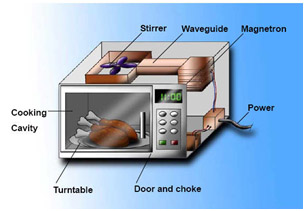 The magnetron is an old invention from 1921. Nevertheless, it has played very prominent roles both commercially and industrially into present day, from military radar to the microwave oven.
The magnetron is an old invention from 1921. Nevertheless, it has played very prominent roles both commercially and industrially into present day, from military radar to the microwave oven.
A magnetron consists of two parts: the tube core and the electromagnet.
In the tube core, the filament (cathode of the tube) which is carefully sealed into the tube is placed at the centre of the magnetron. The anode is a hollow cylinder of copper which surrounds the cathode and the tube core.
A magnetic field is provided by an electromagnet in parallel to the filament, hence when the electrons are accelerated from cathode to anode, they spiral outward in a curve rather than moving directly to the anode.
The anode block of the tube includes many cylindrical cavities, which each serve as a resonant RC circuit, causing electrons to bunch into groups. Microwaves are emitted by this interaction of the electrons with the magnetic fields and the arrangement cavities. An antenna will transmit a part of the RF energy.
Magnetron in microwave oven:
The microwave oven is one of the most widely used household appliances. The reason for its popularity is its ability to heat food quickly and efficiently. The magnetron is the heart of every microwave oven.
How does the microwave oven work? As its name suggests, microwave oven uses non-ionizing microwave radiation to heat food. In order not to interfere with radar and other communication systems, the frequency of microwaves generated by the oven is usually designed to be 915MHz or 2.45 GHz.
The transformer in the oven raises the 220V household voltage to 3,000V or more and delivers it to a magnetron. The magnetron generates  microwaves, sending them through a waveguide into the cooking cavity. The stirrer at the end of waveguide distributes the microwaves evenly.
microwaves, sending them through a waveguide into the cooking cavity. The stirrer at the end of waveguide distributes the microwaves evenly.
Not everything is heated in the microwave oven. Energy from the microwaves is only absorbed by water, sugar, fat etc. which are electric dipoles. (Electric dipole is a polar molecule with equal and opposite electric charges.) As the microwaves consist of oscillations of electric field and magnetic fields, electric dipole molecules tend to align themselves with electric field because they have positive charge and negative charge on opposite sides. The electric field in microwaves reverses billion of times a second, causing the molecules to turn back and forth, bump, and producing heat rapidly. Glass, ceramics etc. which do not have the freely rotating dipoles are consequently barely heated in a microwave oven.
Further Reading/ References:
1.
www.ccohs.ca/oshanswers/phys_agents/microwave_ovens.html
2. www.en.wikipedia.org/wiki/Magnetron